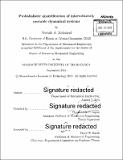| dc.contributor.advisor | Themistoklis P. Sapsis. | en_US |
| dc.contributor.author | Mohamad, Mustafa A | en_US |
| dc.contributor.other | Massachusetts Institute of Technology. Department of Mechanical Engineering. | en_US |
| dc.date.accessioned | 2016-03-03T21:03:52Z | |
| dc.date.available | 2016-03-03T21:03:52Z | |
| dc.date.copyright | 2015 | en_US |
| dc.date.issued | 2015 | en_US |
| dc.identifier.uri | http://hdl.handle.net/1721.1/101481 | |
| dc.description | Thesis: S.M., Massachusetts Institute of Technology, Department of Mechanical Engineering, 2015. | en_US |
| dc.description | Cataloged from PDF version of thesis. | en_US |
| dc.description | Includes bibliographical references (pages 65-69). | en_US |
| dc.description.abstract | In this work we consider dynamical systems that are subjected to intermittent instabilities. The presence of intermittent instabilities can be identified by large amplitude spikes in the time series of the system or heavy-tails in the probability density function (pdf) of the response. We formulate a method that can analytically approximate the response pdf (both the main probability mass and heavy-tail structure) for systems where intermittency is important to quantify. The method relies on conditioning the probability density function on the occurrence of an instability and the separate analysis of the two states of the system, the unstable state and the otherwise stable state with no intermittent events, according to a total probability law argument. In the stable regime we employ steady state assumptions, which lead to the derivation of the conditional response pdf using standard methods for random dynamical systems. The unstable regime is inherently transient and to analyze this regime we characterize the response under the assumption of an exponential growth phase and a subsequent decay phase until the system is brought back to the stable attractor. The separation into a stable regime and unstable regime, allows us to capture the heavy-tailed statistics associated with intermittent instabilities. We illustrate the method on three prototype intermittent systems and show that the analytical approximations compare favorably with direct Monte Carlo simulations. We consider the following applications: an intermittently unstable mechanical oscillator excited by correlated noise; a complex mode in a turbulent signal with fixed frequency, where nonlinear mode interaction terms are replaced by a stochastic drag and additive white noise forcing; and a stochastic Mathieu equation, featuring intermittent parametric resonance. | en_US |
| dc.description.statementofresponsibility | by Mustafa A. Mohamad. | en_US |
| dc.format.extent | pages | en_US |
| dc.language.iso | eng | en_US |
| dc.publisher | Massachusetts Institute of Technology | en_US |
| dc.rights | M.I.T. theses are protected by copyright. They may be viewed from this source for any purpose, but reproduction or distribution in any format is prohibited without written permission. See provided URL for inquiries about permission. | en_US |
| dc.rights.uri | http://dspace.mit.edu/handle/1721.1/7582 | en_US |
| dc.subject | Mechanical Engineering. | en_US |
| dc.title | Probabalistic quantification of intermittently unstable dynamical systems | en_US |
| dc.title.alternative | Probabilistic quantification of intermittently unstable dynamical systems | en_US |
| dc.type | Thesis | en_US |
| dc.description.degree | S.M. | en_US |
| dc.contributor.department | Massachusetts Institute of Technology. Department of Mechanical Engineering | |
| dc.identifier.oclc | 938679299 | en_US |
